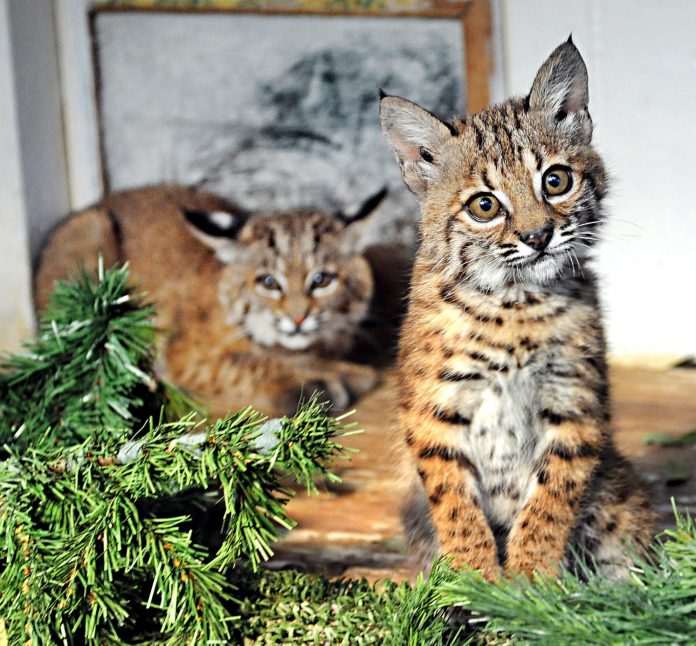
WERC, the Wildlife Education and Rehabilitation Center of Morgan Hill, is celebrating 20 years of successfully raising and releasing orphaned or injured bobcat kittens back to their native habitat using innovative and life-saving techniques.
The unprecedented procedure began in September 1994 when WERC became the first wildlife organization in the world to apply birds of prey anti-imprinting techniques to bobcats. This technique involves costuming caregivers to simulate mother-infant interaction. The kittens are raised, trained and cared for entirely by “foster” mothers who, to make themselves as unlike a human as humanly possible, dress in full-body fur costume scented with bobcat urine and native herbs and work in complete silence to prevent any positive association with humans. This technique ensures that the bobcats don’t become habituated to their human caretakers and remain wild and wary of people when they’re released back to their native habitats. The method has proven successful with more than 40 bobcats over the years and WERC has been internationally recognized for its bobcat kitten protocols.
Now, once again, WERC is hard at work making sure that two little kittens will grow up to be truly wild wildcats.
On July 10, a Fairfield resident noticed his dog was curious about something by the side of his fence. He found a tiny bobcat kitten, weak and struggling in the street. Concerned for its health and the danger from passing vehicles, he captured it in a kennel and moved the kennel to a safe spot, where he watched from afar to see if the mother bobcat would come by. When it appeared obvious that the kitten was alone, he brought it to Suisun Wildlife Center. There is a possibility that the bobcat was orphaned when its mother was shot.
Suisun Wildlife transferred the bobcat to WERC in order for it to undergo WERC’s intensive orphaned bobcat program. Named “Fairfield,” the bobcat was given an acquisition exam at Princevalle Pet Hospital in Gilroy, where it was determined that he was about 10 weeks old and suffering from severe malnourishment (he weighed just 2.5 pounds, which is about half of what a healthy 10-week-old bobcat should weigh), fleas, ticks and internal parasites. With treatment, which included medications and a special high protein diet, he quickly gained weight and now weighs almost 6 pounds.
On July 9, a group of Girl Scouts and a ranger at Huddart County Park in San Mateo rescued a baby bobcat being attacked by a flock of ravens. Brought to the Peninsula Humane Society in San Mateo, the bobcat was stabilized then transferred to the Wildlife Center of Silicon Valley where it was confirmed the10-week-old bobcat was suffering from severe malnutrition and a minor skull fracture and puncture wounds.
After three weeks, when the injuries had healed and the bobcat was gaining weight, WCSV began networking with local groups to find the bobcat a buddy around the same age and size to continue her rehabilitation with. Having a “playmate” to grow up with helps ensure that the bobcats will remain wild and not become habituated to humans. Because WERC had not had a bobcat in rehabilitation for almost three years, it was serendipitous that it currently had a bobcat the same age.
WERC has named the female kitten “Matty,” after San Mateo. When Matty was first introduced to her roomy new habitat, she scampered round and round, happily exploring the new smells and views in the enclosure. Fairfield was very shy, but also very curious at the new companion, though he stayed up on the platform just watching her. Fairfield eventually came down to eat dinner and meet Matty, but it was several days before she gathered up her courage to go up the ramp and join him on the platform.
For the next four months, Fairfield and Matty will remain in the double-length bobcat enclosure, with lots of room to roam, jump, climb and run. They will build up their strength and weight and become acclimatized to outdoor weather conditions. In the fall, when they are at least 6 months old (the age when wild bobcats begin to attain independence from their mothers and strike out on their own), proven their hunting abilities and are certified healthy, they will each be returned to an appropriate area near where they were found—a habitat where there is a plentiful source of natural food, such as field rodents and wild rabbits and access to water such as rivers, creeks, lakes or ponds, especially important during droughts. They will once again be healthy, wild and free.









